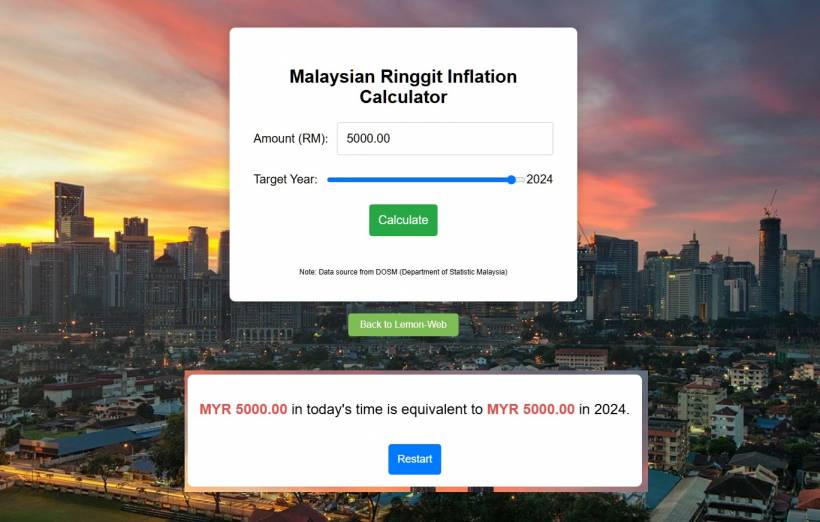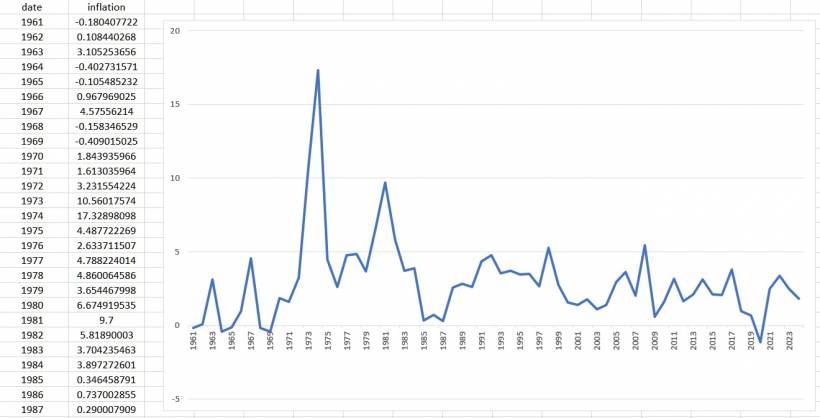The Malaysian Ringgit Inflation Calculator is a powerful tool designed to help Malaysians determine how much their money's purchasing power has changed over time. Whether you're comparing past salaries, property values, or savings, this tool allows you to calculate the real value of your money today compared to years ago. By utilizing historical inflation data from the Department of Statistics Malaysia (DOSM), this calculator provides an insightful way to understand monetary value trends and forecast future financial decisions.
A Brief History of the Malaysian Ringgit
The Malaysian Ringgit (MYR) was introduced in 1967, replacing the Malaya and British Borneo dollar. Over the decades, the Ringgit has undergone various economic shifts influenced by global oil prices, political stability, and regional financial crises. In 1998, during the Asian Financial Crisis, Malaysia pegged the Ringgit to the US Dollar at RM3.80 per USD to stabilize the economy, a policy that lasted until 2005. Since then, the Ringgit has been floating, influenced by market demand and supply.
Inflation Trends in Malaysia (1969 - Present)
Inflation, the rate at which the general level of prices for goods and services rises, has fluctuated significantly in Malaysia over the decades. The highest inflation rate recorded was in 1974 at 17.33%, mainly due to the global oil crisis. Other notable spikes include 1981 (9.7%), 1998 (5.27%) during the Asian Financial Crisis, and 2008 (5.42%) due to global recession concerns.
Conversely, there have also been years of deflation, such as 2020 (-1.14%), reflecting the economic impact of the COVID-19 pandemic. The inflation data from 1969 to 2024 reveals Malaysia's economic resilience and provides insight into how the Ringgit's value has evolved over time.
Understanding the Inflation Graph
The inflation rate over the years is best visualized through a graph, which illustrates the fluctuations in Malaysia's economic history. The graph clearly shows spikes during major global economic crises and periods of stability where inflation remained moderate. By analyzing these trends, users can better understand the impact of inflation on savings, wages, and purchasing power.
For instance, in the 1970s, inflation soared due to the oil crisis, while the 1980s and 1990s saw relatively moderate fluctuations. The 2008 global financial crisis caused a sharp rise in inflation, and more recently, Malaysia experienced deflation in 2020 due to the pandemic's economic slowdown. Understanding this graph helps users make informed financial decisions, such as adjusting investment strategies or cost-of-living expectations.
How the Malaysian Ringgit Inflation Calculator Works
The Malaysian Ringgit Inflation Calculator uses a formula based on historical inflation rates to determine the present-day value of a given amount from any past year:
This formula is applied iteratively across the years selected to adjust the amount based on actual historical inflation data. The app provides an accurate estimate of how much a given sum from the past would be worth today, helping users grasp how inflation has eroded purchasing power over time.
Why Use the Inflation Calculator?
- Financial Planning – Helps individuals understand how inflation impacts their savings and salaries.
- Investment Decisions – Provides insights into long-term purchasing power trends.
- Historical Comparisons – Allows Malaysians to compare wages, property values, and costs across different decades.
- Budgeting and Forecasting – Helps businesses and individuals make informed financial projections.
Conclusion
Inflation is an inevitable economic factor that affects everyone. The Malaysian Ringgit Inflation Calculator is an essential tool for understanding the past, assessing the present, and planning for the future. By leveraging historical inflation data from DOSM, this tool provides valuable insights into Malaysia's economic landscape and monetary value trends. Whether you're an investor, financial analyst, or just someone curious about how much your RM100 in 1980 would be worth today, this calculator helps demystify the complex effects of inflation and economic shifts.
Explore the Malaysian Ringgit Inflation Calculator today and gain a better understanding of your money's real worth over time.


